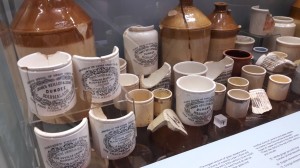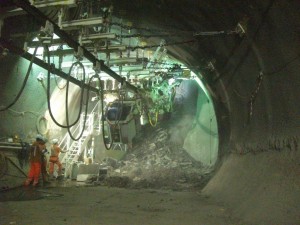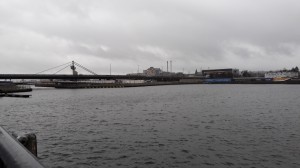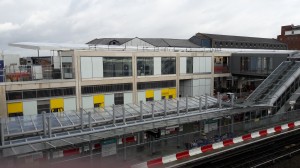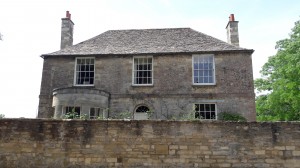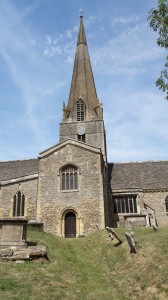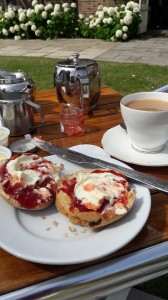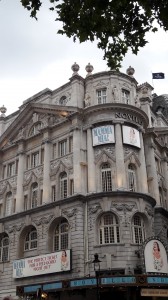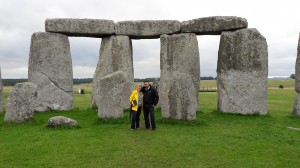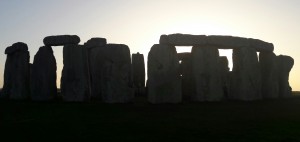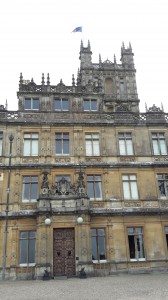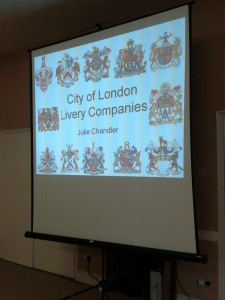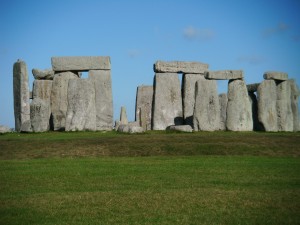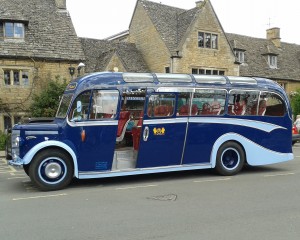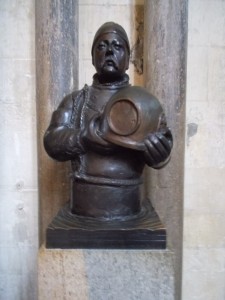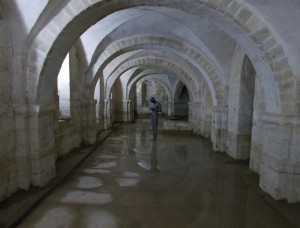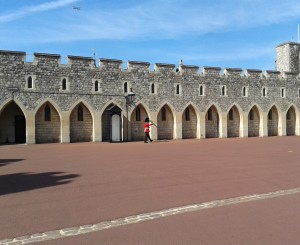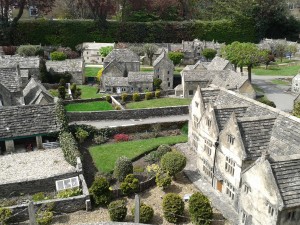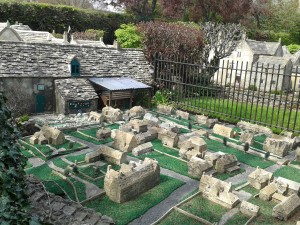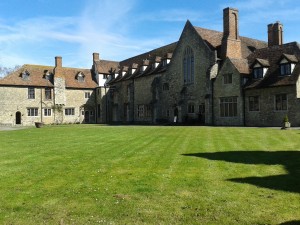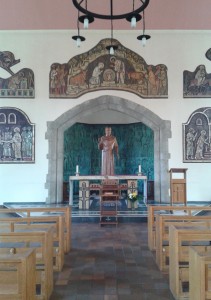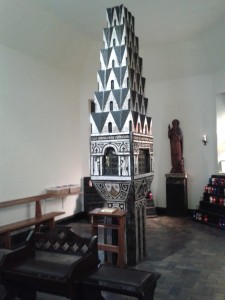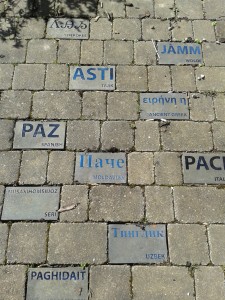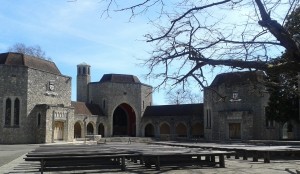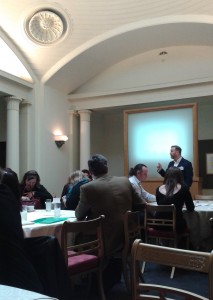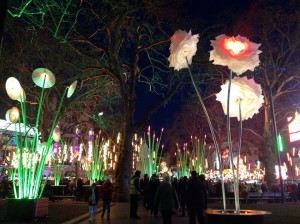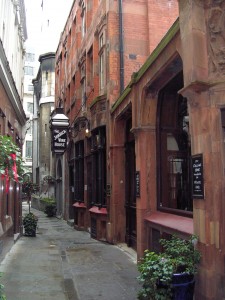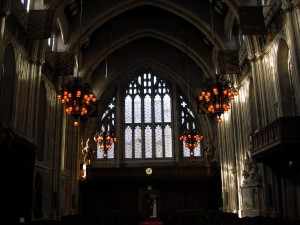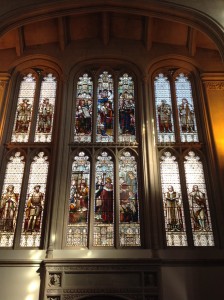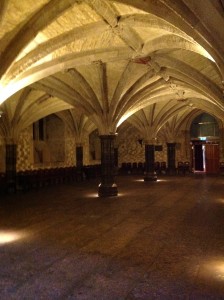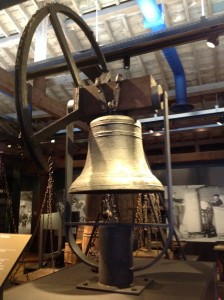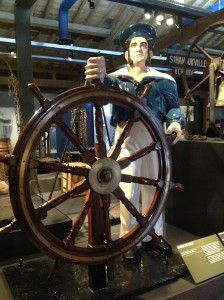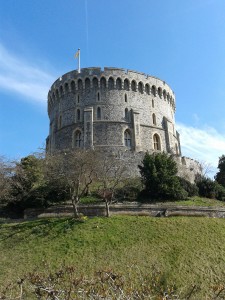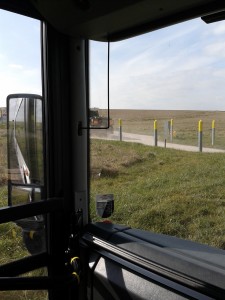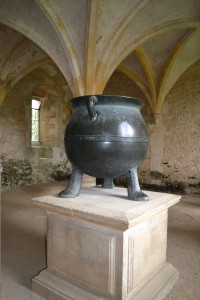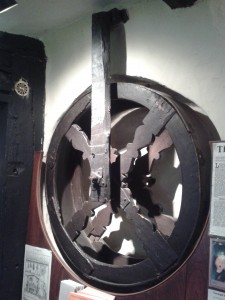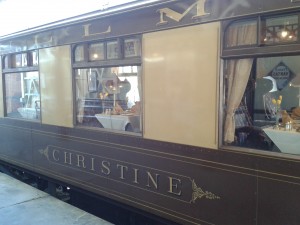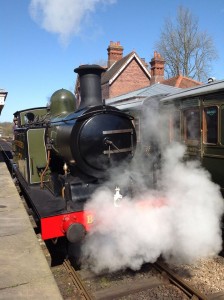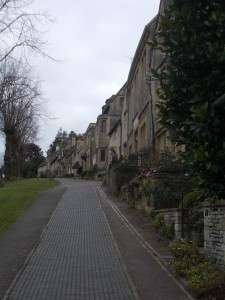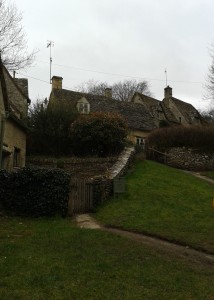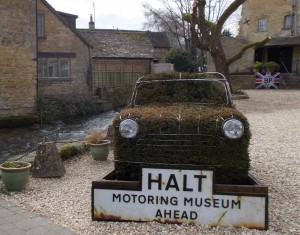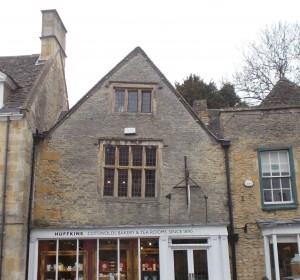Julie
Life of a Guide – Crossrail Top 10
Over the last seven months, to accompany the Museum of London Docklands’ exhibition ‘Tunnel: The Archaeology of Crossrail’, I’ve led a series of 10 walks along the Crossrail route in London. We started at Plumstead in the east back in February, and finished at Royal Oak in west London a couple of weeks ago.
Along the way the walks took in new stations, building sites, and ventilation shafts as we followed the line of the new tunnels through Woolwich, Canning Town, Royal Victoria Docks, Stepney Green, Whitechapel, Canary Wharf, Liverpool Street, Moorgate, Barbican, Farringdon, Charterhouse Square, Tottenham Court Road, Bond Street, and Paddington.
It’s been an interesting and rewarding journey – mostly dry, often sunny and full of people who, like me, have been sucked into the story of the creation of this amazing new railway. I’ve learnt loads (particularly about tunnelling, ground movement and sprayed concrete lining), become incredibly geeky about Crossrail and have even been ‘checked out’ by some of the contractors as I delivered the tours – a few have stopped to listen as they’ve walked past me and my group. I must have been saying something right, as they appeared to give a seal of approval as they nodded, smiled and, in one case at Custom House, winked at me.
My ‘man at Crossrail’, Events Coordinator Adam, has been incredibly helpful and generous with both his time and the sharing of his knowledge and insider information, and I really could not have done it without him. Likewise, Jackie Kiely, curator of the Tunnel exhibition, has been a great support and fountain of knowledge on the archaeology discovered during the building of Crossrail.
As the walks have now finished (although who knows, maybe I’ll get to repeat some of them), I’ve taken a look back and come up with my Top 10 favourite Crossrail facts.
10) Muck Away. During construction, over 7 million tonnes of spoil were mined from beneath London, 98% of which was recycled. It was used for all sorts of projects; some went to turn landfill sites into reusable land, some went to farmers who wanted to create new grazing areas for livestock, and some even went to create a golf course. However, the largest amount of excavated material, over 3 million tonnes, was taken out to Wallasea island in Essex to help the RSPB create a nature reserve that is twice the size of the City of London. Oh, and did I mention that about 80% of all that spoil was transported by rail and water, thereby avoiding large numbers of lorry journeys across London. So the new purple Elizabeth line is green too!
9) Tunnelling came close (very close) to Underground passengers going about their daily commutes. At Tottenham Court Road, Tunnel Boring Machine (TBM) Ada came within 90cm of the live Northern line platforms, and within 60cm of the passenger escalators. If you listened carefully at the time, you could have heard the hum of the cutterhead!
8) Marmalade jars – in among the 10,000 artefacts, covering a timespan of 55 million years, the archaeologists found marmalade jars! Thousands of ceramic jars discovered at the old Crosse and Blackwell factory in Soho Square. Yes, I loved that archaeologists finally managed to prove death by Y Pestis (plague / Black Death) in the 14th century through DNA analysis, and that the jawbone of a mammoth was found at Canary Wharf, and that Isambard Kingdom Brunel’s engine sheds were discovered at Westbourne Park, but I really really love that the archaeologists got just as excited by….marmalade jars!
7) The recruitment consultant who quit her job to become a crane operator. The extended Crossrail family of staff and contractors is an incredibly diverse body of people, with at one time 30% of the integrated workforce being female (against a construction industry average of 11%). One of those is former recruitment consultant, Katie Kelleher, who got hooked on Crossrail when she was recruiting many of their staff. So interested did she become that, without telling anyone, she went for an interview and became an apprentice crane operator with Laing O’Rourke. Katie then spent months sitting in the cab of her 60-tonne crawler crane at the western end of the new Tottenham Court Road station. Now that’s geeky!
6) An uphill excavator was used for the first time in the UK. Because of difficulties accessing the station to dig downwards to build the inclined barrel-shaped tunnel for the escalators at Whitechapel Station, an uphill excavator was used. Starting at platform level, the excavator worked its way upwards some 30m to street level. Traditionally used in coal mines, the excavator was designed to do two jobs in one. Working its way up using the digger at the front, it also installed concrete lining using a spray nozzle attached to the top of the machine while the entire excavator hung on chains from bolts drilled in the ceiling of the tunnel.
5) No fish were hurt in building of this railway! At both Royal Victoria Dock and Canary Wharf, the project needed the docks to be drained of water to facilitate some of the construction work. Some 98 million litres of water were drained from inside a cofferdam for enabling works for the new Canary Wharf station and 13 million litres were drained from Connaught Passage in Royal Victoria Docks to allow access from above into Connaught Tunnel. In both cases, all the fish were caught and relocated before the docks were drained – 332 fish to be exact at Royal Victoria Docks (can you believe someone actually counted them?!)
4) A pre-fab station at Custom House. Architects Allies and Morrison designed a freestanding building with an elevated concourse above, using thousands of pre-cast concrete segments. As the construction site was very compact, 887 pre-cast concrete sections were manufactured in Nottinghamshire and delivered to site for assembly – a bit like building out of LEGO, although I’m pretty sure it was much more complex than that. What I love about this though is that, during their tender bid for the contract, they turned up at the interview and presented the station to the panel in model form in a mocked-up Hornby train set box. They then tipped it out on the desk and asked the interviewing panel to put it together!
3) Floating track – there’s 57km of track installed in London….and some of it floats! Sounding very Harry Potterish, I know but floating track slabs have been installed to minimise noise and vibration in sensitive areas. Underneath the nightclubs and recording studios of Soho, light floating track has gone in, with heavy floating track being installed beneath the Barbican’s concert hall. A very clever but complex method cushions the track with use of springs and rubber bearings. Because of the extra depth of the floating track, shallower sleepers made of denser concrete also had to be used in these areas.
2) They buried a time capsule. Not content with uncovering 55 million years of archaeology, the Crossrail team buried some future archaeology of its own. In honour of the final breakthrough and completion of the tunnels, the cutterhead of TBM Phyllis was buried at Farringdon. Alongside, Crossrail used a small drum from the TBM to create a time capsule and filled it with objects suggested and donated by key stakeholders, local people and Crossrail workers, including a 2013 edition of the London A to Z (originally created by TBM namesake Phyllis Pearsall), a tunnel phone that was used to communicate without a standard telephone signal, a Crossrail mug, model train, newspapers from the week it was sealed, a copy of Private Eye, Crossrail PPE, and a copy of the Crossrail monthly ‘On Site’ newspaper. I wonder if archaeologists in a couple of hundred years will be as excited as those who discovered the marmalade jars?
1) But my favourite all-time Crossrail fact has to be that the average mole tunnels at rate of 800m an hour, whereas the average TBM tunnels at rate of 0.6m an hour. Seriously, they should have just bred giant moles!
Life of a Guide – Scones and Stones
A quieter week, which started with a lovely tour to Highclere Castle, better known to its legions of television fans as Downton Abbey.
Before we got there though, I wetted my group’s appetite with a visit to the village of Bampton. A beautiful village, with stone cottages and thatched roofs, that stood in as the fictional village of Downton.
In the village, you will find the cottages that stood in for Downton’s two pubs; The Grantham Arms and The Dog and Duck, the cottage that became the village post office and the old King Edward VI Grammar School, which today is the village library but, in the series, was the cottage hospital. We also found Isobel Crawley’s house.
The 12th century church of St Mary the Virgin is, of course, where all the main action happened. The weddings of Lady Mary….twice (first to Matthew Crawley and then Henry Talbot), Carson the butler to Mrs Hughes the housekeeper, Anna the ladies maid to Mr Bates the valet, and Lady Edith to Bertie Pelham. The funeral of Matthew Crawley, killed returning from seeing his wife, Lady Mary, and new born son in hospital. The christening of baby Sybil, the child of the youngest of the Grantham daughters Lady Sybil and her husband Tom Branson, the chauffeur. And of course, the jilting at the altar of Lady Edith by the much older Sir Anthony Strallen!
From there, we ventured on to Highclere Castle and, while my group enjoyed a visit to the house, my driver and I enjoyed a very nice cream
tea. There is no guiding allowed inside Highclere as it is ultimately a private family home for the Earl of Carnavon and his wife, Fiona, the Countess. So I always have a cream tea when there and then take a stroll through the beautiful gardens, which were designed by the 17th century landscape artist Capability Brown.
I occasionally give lectures to a variety of groups and so it was that I had a lovely day close to home when I was invited to speak to the Surbiton Probus Group on the City of London Livery Companies. What made this one really special id it was the first time my lecture was preceded by a 3 course lunch.
The venue was a wonderful Victorian building, and lunch was a delicious spinach and mushroom stuffed pancake, followed by salmon fillet with new potatoes and asparagus, and finished off with strawberries and cream. After that, I could have done with a siesta rather than giving a lecture…..and clearly so could some of my audience as one or two of the gentlemen nodded off in the middle of my talk! Mind you, some of them were in their 90s so I wasn’t surprised.
On a rare day off, I joined some of my City of London guide colleagues one evening for a walk around Theatreland. Over the summer months the City Class of 2009 meets up once a month, with one of us leading a walk before we all head to a pub for a drink and a catch up. My colleague Andrew delivered a great walk around the Covent Garden area and, believe me, taking a group of guides on a walk requires some nerve as we make terrible tourists!
Andrew’s walk featured some great tales of theatres and theatre folk as we visited St Paul’s Church (also known as the Actors’ Church), the Vaudeville Theatre, Adelphi, Theatre Royal Drury Lane, the Duchess and the Novello Theatres.
As a guide, it’s always interesting to hear other guides and see what they include and their style because you always learn something new. For me, it was that the Theatre Royal Drury Lane has not one, but two royal boxes. Apparently because both George III and the Prince Regent (future George IV) would visit – once to see the same play, and when they met in the foyer George III slapped his son round the face and boxed his ears!
My week finished with one of my favourite tours – a trip to Stonehenge to see the sunrise. Well, in reality we didn’t see the sunrise because we would have had to be there around 5.00am, but we did have an early morning private visit with, always the best bit, access into the stone circle.
However, it was a very early start. Up at 2.30am, a drive to the very unglamorous coach yard on the Old Kent Road to meet my coach and driver, then to pick up the passengers from a hotel before heading down to Wiltshire to see the prehistoric stone circle.
Now I have lost count of how many times I’ve been to Stonehenge, and Ricardo my driver has been there even more times than me. But he has never been up to the stone circle – he’s always either going to fill the coach up with fuel, grabbing a coffee and a break or sitting in the coach park chatting to other drivers. So today he decided he would like to come with me. Trust me getting a driver to go up to ‘the rocks’ is incredibly rare because most of them really don’t appreciate the enormity of the construction and don’t get why so many people want to see it.
However, we had a fun time in the stone circle and I ensured we got a couple of photos to prove that Ricardo actually went up to the stones. He won’t admit it but he secretly enjoyed himself (he was taking loads of selfies with the stones), and I was feeling very pleased with myself. Then, as we walked back to the coach, he spoilt the moment as he said “That was great, but it was definitely built by aliens!”
Life of a Guide – 7 days on the Trot!
Well, it has been over a year since I wrote my last blog as events, well work, just overtook me. The life of a guide is a busy and varied one, but it is high time I restarted my blog, so here goes.
Peak season is upon us, London is having another bumper year for tourism, and I’ve just finished working seven days on the trot!
My week started with a visit to Stonehenge at 7.30 in the morning, which meant the alarm going off at 2.45am, leaving home at 3.30am to meet the coach on Old Kent Road and then picking up the passengers from their hotel at 5.00am. As the coach driver and I both wondered what on earth had possessed us to do this trip, I was also silently praising the person who invented travel mugs – as I at least could take a cup of tea with me!
However, the early start was worth it as a private access visit to Stonehenge early in the morning with just me, my group and a security guard is very special.
Built around 4,500 years ago by Neolithic man, and perfectly aligned with the solar and lunar calendars, we are talking precision engineering long before we’d even invented engineering!
Large Sarsen stones, each weighing approximately 30 tons, form the outer stone circle, with about two thirds of each stone above ground and one third below. Coming from the Marlborough Downs, roughly 19 miles away, archaeologists estimate that it took about 100 men to drag each stone across the landscape.
The inner stone circle of Bluestones, still pretty heavy at about 5-7 tins each, come from the Preseli Hills in Wales, roughly 150 miles away. But it is the trilithons in the centre that really dwarf you. Huge sarsen stones, grouped in threes (trili is Greek for three) with two upright stones and a horizontal stone on top, there were originally five trilithons forming a horseshoe in the centre.
Stonehenge is an amazing place whenever you see it but, when you get to stand inside the stone circle in the peace and quiet with just the birds chirping, it is truly spectacular and my group were suitably overawed, with many of them confessing it had been on their bucket lists to do.
Tuesday saw me in the 1920s, as I took a group to Highclere Castle on a Downton Abbey tour. Now I love Downton Abbey, never missed an episode, so to be paid to go to ‘Downton’ and relive the television series is lovely.
The family home of the Earl of Carnavon stood in for the fictional Downton Abbey and many of its famous scenes were filmed there, from the opening of the first episode when the tel.egram boy cycled up the drive to deliver the news that the heir to the title and estate had gone down with the RMS Titanic, to the final episode when Lady Edith finally got married and lady’s maid Anna gave birth to a son on New Year’s Eve 1925.
Highclere Castle itself is a fabulous place with its elegant rooms, portraits of Carnavon ancestors, family photos of the current earl and his family (it is first and foremost a family home), and Tutankhamen objects – the 5th Earl discovered King Tut’s tomb with archaeologist Howard carter back in 1922. My group loved their visit, even if they didn’t get to see the beautiful gardens landscaped by Capability Brown in the 18th century, as the rain was torrential the whole time we were there.
As usual, I got to enjoy a nice cream tea with my driver while my group explored the house and raided the gift shop for souvenirs. The highlight though is, of course, as we motor up the drive to the house and I play the Downton Abbey theme tune over the microphone as my group laugh, cheer and clap!
Wednesday was another full day trip, this time to Stonehenge and Bath. I had a nice cup of tea while my group went up to the stone circle – I had told them all about it on the way there, so a self-directed visit was in order. Then at Bath, once I had got my group inside the Roman bathhouse and sorted their audio guides, I took the opportunity to grab a sandwich before I met them as they exited the Roman baths and pointed them all in the right direction for the various other visitor attractions and refreshment places fot hem to enjoy in their free time.
On returning to the coach pick up point to meet my group, I had a chat with the coach marshal about upcoming road closures for the annual Bath Carnival. Visiting places regularly, you get to know the coach marshals and staff at heritage sites and Steve is no exception. We always have a nice chat, I just wish I could get him to stop calling me ‘Prozac’ in front of my groups – he has nicknames for all the regular guides!
The following day was spent in London with a lovely American family. Their first time in London, so we did all the main sites; a full guided tour of Westminster Abbey and the Tower of London, plus a walk past No 10 Downing Street, Big Ben, Horse Guards, and St Paul’s, before finishing the day outside Buckingham Palace.
A great day, only marred by the confusion when I arrived at their Air BNB flat in Pimlico and discovered multiple doorbells and their mobile phone was switched off! Luckily, they had the sense to come outside
and look for me at the agreed meeting time – phew!
Friday was an easier day (thank goodness) as I had a panoramic tour of London on a minibus with a group of American gardeners. A late start, meeting them at their hotel at 11.30am, and an early finish as I dropped them at Kensington Palace for their visit there, made for a nice change. I had done a similar tour last year, so it was like meeting up with old friends as I had the same tour leader, lead client and coach driver from 2016.
Saturday saw me back at Stonehenge and Bath with a stop at Windsor Castle along the way and with a double decker coach and 72 passengers – eek! Even though Bath Carnival was on, the day went smoothly and on the return my driver and I settled an argument about the quickest return into London via the toss of a coin. I called heads, so we came off the M3 onto the M25 and then into central London via the M4 / A4 rather than via Twickenham and Richmond – the guide is always right lol!
My incredibly busy week saw me finish with another full day London tour for a group of 32 that included the Changing of the Guard at Buckingham Palace, the Tower of London and a private cruise down the Thames. Unfortunately, it also included a run in with a traffic warden whilst I was picking up after the guard change. Despite the fact that other coaches were picking up their groups near the palace, he decided that we weren’t supposed to stop where the coach had (strictly speaking that’s true, but everyone does it because there is nowhere else to stop), and refused to let me board my group. I pleaded, I begged, and even fluttered my eyelashes, all to no avail. In the end, my driver moved off and I walked the group much further away to board in Victoria.
Hopefully all the other guides and coach drivers, who were happily boarding their groups, appreciated my sacrifice!
Diary of a Guide…Art and a Vintage Bus
A mixed bag this week of coach tours, a lecture and a visit to the National Gallery.
Wednesday
This afternoon I was off on the train to Luton to give a talk to Luton U3A (University of the Third Age) History Group on the City of London Livery Companies.
As a City of London Guide, I often give lectures on ‘City’ topics and love talking about the livery companies; their origins, history and function – both hundreds of years ago and today.
Luton U3A are a great group to give a talk to; always interested and they always ask lots of questions afterwards. I started giving lectures to them about 18 months ago when I was booked to give a talk to Dunstable U3A and then they passed me on to Luton U3A, who passed me on to another local U3A group, who also passed me on to another local history group. It’s a bit like Pass the Parcel in this game – once you give a talk, and they like you, they pass your details onto others they know and you go and give talks to them too.
So now I go up to the Luton area about six times a year. One of the members meets me at the station, I give my talk, have a nice cup of tea, and then I get dropped back at the station. Just lovely.
Thursday
A full day’s tour today. I was due to take a coach load to Stonehenge and Bath, but added on a stop at Windsor on the way following a call from the tour operator yesterday.
Once I’d got my group into Windsor Castle, given them a short tour of the castle precincts and left them to visit the State Apartments on their own, I met up with a fellow Blue Badge Guide who I hadn’t seen for a few months for a coffee and a catch up. One of the nice things about this job is that you occasionally end up in the same place at the same time as a friend. Lucy and I trained together on the Blue Badge course and during the main season it’s hard to meet up properly, so we grab time when we can to share stories and swap tips.
Back in the coach park, two of my visitors were late back and in the end I had to head off to Bath without them – there’s only so long you can make 50 other people wait! However, the tour operator was able to contact the missing couple and another coach gave them a lift from Windsor to Bath, where we were reunited just in time to go into the Roman Baths. The couple were terribly apologetic and admitted it was all their fault as they had just lost track of time in the castle.
Our final stop of the day was Stonehenge – it was beautifully sunny and, as my group left the coach, one man asked if he’d need his umbrella. I laughed and said: “Nah, it’s not going to rain today”. Famous last words! Once the group were up by the stones, which are 1½ miles from the visitor centre, guess what? It rained! Luckily not too much and not for long, but it did rain. Boy, did I get some stick back on the coach.
Friday
Today was a day off, but I’d offered to take a couple of Blue Badge students on a walkthrough of the National Gallery so headed out reasonably early to meet them. They have their exam (a tour of the gallery) in September and it’s hard – there are 21 paintings on the tour and you have to be able to deliver a 5 minute presentation on all of them. I remember my training and exam well. I felt like I would never be able to find my way through the gallery from one painting to the next, let alone be able to talk about each one.
Art was never really my ‘thing’, but once I realised that I could talk about the stories in the paintings and not just the history of the art, the paint techniques and the artists, it became much easier. It was still a tough exam, but I actually started to enjoy the art. I love that Caravaggio was the bad boy of the art world in the early 1600s (arrogant, he would swagger around town with his mates, and he killed a man in a duel), that Constable’s The Haywain is like a chocolate box cover, and that a suffragette slashed The Rokeby Venus with an axe to highlight the struggle for women’s votes in 1914 (well, not that she damaged the painting but the passion it inspired in her). On her arrest, Mary Richardson said: “I have tried to destroy the picture of the most beautiful woman in mythological history as a protest against the Government for destroying Mrs Pankhurst, who is the most beautiful character in modern history.”
I hadn’t been to the National Gallery for a while, so today’s walkthrough with some students was a good chance to refresh myself on the art while giving them some guidance on how to talk about each painting. We only managed to talk through 12 paintings in the time we had, plus after 12 we were all feeling a little brain dead, so we called it a day and agreed to finish off another time.
Sunday
Back to the Cotswolds today on a lovely sunny Sunday, with a trainee coach driver who hadn’t done this route before. Occasionally with new drivers you have to direct them as well as provide the commentary, which is pretty hard work but, luckily for me, the tour company sent along another driver to act as his mentor and make sure he knew what he was doing and where he was going.
The day went well, no wrong turns, no one left behind anywhere, the sun shone all day and the passengers enjoyed their trip out into the countryside.
However, I was very jealous when we got to Bourton-on-the Water and saw another tour in the most gorgeous vintage bus.
Now why don’t I get those kind of tours?!
Diary of a Guide…Coach Trips, an Empty Castle and a Model Village
What a week! It started with a fun but hectic cruise ship pickup and finished in a model village, which has its own model village!
Tuesday
When the alarm went off at 3.15am, I wondered what on earth had possessed me to accept a cruise ship job. Before you start thinking ‘how lovely’, let me just clarify that this is not me enjoying a cruise, but picking up a coach load of tourists from a cruise and taking them on a shore excursion for the day.
I struggled out of bed and brewed up my flask of tea – can’t survive an early start without it, and there is nothing at Southampton Docks apart from a rubbish vending machine that is often broken. My cab picked me up at 4.00am and delivered me to a hotel in Victoria where, along with about 45 other Blue Badge Guides, I boarded the coach to take us down to Southampton. On board there was a weird party-type atmosphere (it was 5.00am!) as people caught up with old friends, swopped notes about which excursion they were leading and dished out advice to guides who’d never done a cruise pickup before.
Once we got to Southampton the sheer scale of the job unfolded. Lined up at the dockside were 101 coaches! A large number were coming back into London for the day and their guides were meeting them there – no early start for them. But the rest of us were taking our coachloads all over the place; Bath, Stonehenge, Windsor, Salisbury. I was Coach Number 37 and was off to Winchester and Oxford for the day, along with about another 8 coaches.
Getting that many people off the cruise ship with their luggage and onto the right coach is not easy, so I eventually left the docks over an hour late. However, that was fine as our first stop was Winchester and a tour of the cathedral, which didn’t actually open until 9.30am. So at least by the time we got there we could go straight in – or so I thought!
This was where I discovered that my Indonesian group were lovely, but uncontrollable. In the five minutes it took to walk them from the coach drop off point to the cathedral, they scattered and I lost two of them who ducked into a shop without me seeing where they went. Having rounded everyone up again, I did the quickest tour ever of Winchester Cathedral and whizzed round telling them about the history and architecture and pointing out the mortuary chests which contain the bones of Saxon kings, including Cnut, and the grave of Jane Austen.
Stopping briefly at the bust of deep-sea diver, William Walker, I told the story of how he spent six years underpinning the cathedral to shore it up working by touch in the dark, murky waters below. The cathedral is built in boggy land and was in danger of collapsing back in the early 1900s, so Walker spent six hours a day in the water below excavating trenches and filling them with bags of cement. His diving suit was so heavy that when he stopped for lunch, he just used to take off his helmet, eat and then go back into the waters.
The cathedral is no longer in danger of falling down, but the crypt still floods regularly.
We were in and out in 30 minutes and then, after they’d all been to the loos, it was back on the coach to try and make up time on the way to Oxford.
We caught up a little on the drive and headed straight into the centre of the city for our lunch stop at The Mitre in the High Street, who did a great job serving 35 tomato soups, followed by 35 fish and chips and then 35 slices of cheesecake in record time.
Because they all wanted to shop, I abandoned the walking tour of the city and gave the group free time before we regrouped for our visit to Christ Church. Probably the most visited college in Oxford, it’s mainly visited for its Lewis Carroll / Alice in Wonderland and Harry Potter connections rather than its history and architecture. However, my group loved it, and we finished the day with a group photo in Tom Quad before boarding the coach for the journey to Heathrow Airport, where I waved them off to get their flights back home, and then headed back into London and home – exhausted, but happy at a job well done.
Thursday
Another coach group today, and this time I spent the day playing catch up as my timings went to pot! I left London a little late as some of my passengers were late arriving for the coach and a family of eight didn’t turn up. So with 63 passengers on board a double-decker coach we set off to Windsor.
Windsor Castle opens at 9.30am and I was pretty confident we would be the first coach there – until we hit the M4! The traffic slowed to a crawl, as there were three separate accidents ahead of us. So instead of getting to Windsor around 9.00am, we didn’t arrive at the Castle gate until 9.45am.
However, we sped through the ticket hall and security as I was still the first coach to arrive (all the others were still stuck on the M4) and I’ve never seen Windsor Castle so empty, not even in the middle of winter. There wasn’t a soul there when we arrived, so it was bliss conducting my tour of the castle precincts without anyone else around, and I got my group straight into the State Apartments.
Back at the coach park after my group had time to explore Windsor and watch the guard change, they came back mostly on time and I was reunited with the family of eight as another coach tour had given them a lift to Windsor. However, we still left later than originally planned as I’d given the group their full time at Windsor even though we’d arrived late.
We made up a little time on the way to Bath, where I walked the group to the Roman Baths and then gave them free time to explore. I grabbed a cup of tea and had a little rest, before meeting my group at the coach pickup point, known as Bog Island (better than it sounds). Two people were late back, so we left Bath later than planned again, and whizzed our way through the countryside to the medieval village of Lacock with its abbey and Harry Potter connections – a house in the village was used as the location for Harry’s parents’ house in the films and filming also took place in the abbey itself.
After a rather late lunch in the 14th century George Inn, we headed to our last stop of the day at Stonehenge and got there with 10 minutes to spare before the last entry – phew!
Friday
Today was much more relaxed as I took a lovely group out to the Cotswolds for the day in the warm sunshine that has finally emerged.
I love guiding in the Cotswolds. It’s just so beautiful and overseas visitors are enamoured with ‘olde England’ – it’s just how many of them imagine England to be with its picturesque villages and quaint cottages.
Our first stop in the village of Bibury went well, until we came to get back on the coach and two of my visitors were missing. I ran round the village (it is not that big) and couldn’t find them anywhere. At this point I was starting to worry – how on earth could I lose two people in a teeny tiny village?! 20 minutes later, just as I was giving up and about to head off without them, they came ambling slowly down the hill from the back of the village without a care in the world and completely oblivious that the other 50 people had been waiting for them!
Our lunch stop in Burford was great – again, it always amazes me how they can get so many meals out at one time, but The Cotswold Arms (not been there before) served lunch quickly which gave the group a little extra time to explore the village. The coach driver and I had a little table in the corner of the bar area, away from the group, so we could relax over lunch. If you ever visit, I highly recommend the homemade steak and ale pie, which I followed up with apple crumble and custard.
Feeling more like taking a little siesta rather than delivering a guided tour, our next stop was Bourton-on-the-Water. My driver kept making fun of me, as I tend to pronounce it ‘Burton-on-the-Water’ rather than ‘Boorton’, but as he kept correcting me, I switched to the correct pronunciation, stressing it accordingly – which just made him laugh even more.
Once there, I managed to take a little time out and visited the model village, which I’ve not managed to get to before.
A visit is well worth it, as it is an exact miniature replica of the village of Bourton-on-the-Water and was built in the garden of the Old New Inn back in the 1930s. The owner at the time, landlord C A Morris, actually measured the village and then recreated it on a scale of 1/9, opening it to the public in May 1937 to celebrate the coronation of King George VI.
The model village is just fantastic with its miniature houses, replica river Windrush running through it, and church complete with singing choir.
The detail is incredible – right down to the miniature Old New Inn pub, which even has a model village in its garden!
Diary of a Guide…Pilgrimage to The Friars
A quite week workwise, so I spent most of the week conducting research in preparation for a tour with a church group in September – and in the process discovered the most beautiful and peaceful priory in Kent.
Tuesday
When the tour operator booked me to take a group on a trip to Aylesford Priory, known as ‘The Friars’, I’d never heard of it and had no idea where it was. But I said yes to the job anyway, figuring that as the tour isn’t until September I had plenty of time to check it out. So with a free day today, I drove down to Kent and spent the day in the calm and inspiring surroundings of a Carmelite priory and place of pilgrimage.
Founded in 1242 when Baron de Grey gave land to a group of hermits that he brought back from Mount Carmel on his return from the Holy Land, the hermits held their first General Chapter (or meeting) in 1247 and became mendicant friars. These early Carmelites offered shelter and respite to pilgrims on their way to the shrine of St Thomas a Becket in Canterbury, and the Pilgrims’ Hall is the earliest building on the site having been built in the 12th century specifically as a stopping place for pilgrims by the original owners.
Like most religious orders, the Carmelites at Aylesford were dissolved by Henry VIII. The church was demolished and the land passed through various owners over the centuries until the Carmelites bought it back in 1949. They restored the buildings and celebrated pilgrimage masses on the lawn that covered the site of the old church.
Today masses are still celebrated outdoors, in front of the main Shrine, and The Friars continues to offer shelter to pilgrims as well as welcoming visitors of all faiths and none. And very welcoming they were too when I went into the reception and explained that I was doing a recce for a Catholic group, was Church of England and had never even heard of them before!
A lovely lady from the office explained all the group booking information to me, including arranging lunch in the old Pilgrims’ Hall, and then gave me an overview of all the buildings before I set off to explore.
All the work to restore The Friars was undertaken in the 1950s and 1960s, and the decoration, mosaics and ceramics in the chapels reflect the style of the day, with sculptures created by father and son team Philip and Michael Clark, and ceramics by Polish artist Adam Kossowski.
First up was The Rosary Way, a tree lined garden where pilgrims can stroll and contemplate. Next I made my way through the various chapels that surround the main Shrine.
The light and airy St Joseph’s Chapel, the family chapel of St Anne’s with ceramics of the Stations of the Cross, the plainly decorated and rather austere Choir Chapel, the Chapel of St Simon Stock (Prior General in 1256) with its eye-catching reliquary containing a relic of St Simon which was brought here from Bordeaux in 1952, and the underground Cloister Chapel, reserved for quiet prayer and dedicated to St Jude the Infant of Prague.
Then I took a stroll in the Peace Garden, which was created in 2010 and has the word ‘Peace’ in 200 languages embedded into the paving stones. It was interesting comparing the words and trying to work out what some of the languages were – I mean, I know what French, Ancient Greek, Cherokee and Welsh are, but where do they speak Wolof or Ingush? Senegal, the Gambia and Mauritania in the case of Wolof, and the North Caucasus region of Russia for Ingush, if you’d like to know.
The whole place exudes a sense of tranquillity and, as I sat for a while in the sunshine on one of the open air pews in front of the main Shrine with its beautiful statue of the Virgin Mary, I could almost feel the thousands of pilgrims seeking calm and refuge who have visited the priory over the centuries.
If you’re ever down in the area, take a detour from the hustle and bustle of Canterbury and maybe make your own pilgrimage to The Friars. I simply cannot wait to show my group of Catholic Americans, the peace of a Carmelite priory in the heart of the Garden of England.
Diary of a Guide…Heroes, Villains and Rain!
Well, this week started in spectacular style with an event at the Queen’s Gallery, then I got soaked in the middle of the week, and it ended with a talk on the Great Fire of London.
Monday
What a great way to start my week – in the fabulous surroundings of the Queen’s Gallery at Buckingham Palace, on an ALVA (Association of Leading Visitor Attractions) workshop on theatre, performance and contemporary art in attractions.
I was attending on behalf of The View from The Shard and the room was filled with people from all sorts of visitor attractions; museums, galleries, heritage sites, gardens. Even representatives from London Zoo were there.
As this was my first ALVA event, I wasn’t sure what to expect, but the speakers were just inspiring. Historic Royal Palaces kicked off talking about their costumed performances for children and also gave an overview of the phenomenon that was ‘Blood Swept Lands and Seas of Reds’ (more commonly known as the poppies) at the Tower of London.
Other speakers talked about collaborations for modern art installations, making the most of the landscape, the cultural legacy of the Olympic Park and theatrical productions, but the highlight of the day for me was Helen Marriage, Chief Executive of Artichoke. And if you’ve never heard of Artichoke, well I only have to say that they were the organisation behind Lumiere London in January this year, and that amazing spectacle will immediately spring to mind.
Helen talked through how the Lumiere London project came about and the challenges involved, not least raising the funding as the project started with no budget. Other challenges came from Transport for London who originally told her that they couldn’t close Oxford Circus for the event. When asked why – because of the commuters. When she said, well we’ll do it after the commuters have gone home, they said no because of the shoppers. She responded with well what if we do it after the shops close, they said no because of people enjoying the nightlife. Finally it all came down to the buses. When asked if they could divert the buses, they said no. That woman must be like a dog with a bone, because she got them to close Oxford Circus for the event – which was just as well because people were lying down in the road taking photographs of the display above them (good job they stopped those buses!)
Thursday
Today it rained. And I got wet. More than once, as that ancient law known as ‘Sod’s’ ensured that I had two walks on a day that was full of showers.
My morning walk, Bawdy Bankside, wasn’t too bad as the showers were more drizzle than proper rain, but it was damp and cold as my group took in the 16th century entertainments on offer on the riverside. We started with the original theatres, The Rose and The Globe, before hearing about American film director and actor, Sam Wanamaker’s, mission to rebuild the Globe as it had been in Shakespeare’s day.
Moving on, we covered the bear baiting that once took place here and, of course, the inns and taverns in the area, The Clink Prison and the Winchester Geese who plied their trade in the brothels and stews.
My group were regulars who normally do country walks, but come into London a couple of times a year for a walk with me, which meant they were dressed for the weather. Good job they were regulars though, as the entire walk ended up revolving around wee – from the urine that people used to sell to the tanners in the area for them to use to soften their leather, to the human and animal urine that Shakespeare’s father would have used in his trade as a glover (again to soften the leather or animal skins). What with all the talk of wee, the sound of the river rushing by and the constant rain, we were all desperate for the toilet by the time we reached Southwark Cathedral, so dived inside to use their facilities and warm up with soup and coffees in their café.
Having dried out, I got absolutely drenched with the corporate group I took on a ‘City Heroes and Villains’ walk this evening. It was drizzling, yet again, but as we left their offices to start the walk, the heavens opened and we got caught in a torrential downpour. Got hand it to them, those bankers are hardy types, as they stuck with me as we galloped through some of the City’s best known and also unheard of heroes and villains. The 1910 Houndsditch Murders where three policemen lost their lives, the destruction caused by the Great Fire of London, the bombing of the Blitz, and London’s first coffee shop (must be a hero to most people these days – who can survive without coffee?).
Along the way we discovered the Boudican revolt against the Romans, the true story of Dick Whittington, Lloyd’s of London (whose reputation was built on settling large claims fast, such as the sinking in 1799 of HMS Lutine and the unsinkable Titanic in 1912), Charles Dickens pricking the nation’s social conscience with his novels, and Thomas Gresham, who aptly built the Royal Exchange in 1571 so traders could meet under cover. Now there’s a man who recognised the problem of London weather!
We finished with one of my favourites, James Greathead, who invented a deep tunnel shield that enabled the City and South London Railway to be built between Stockwell and King William Street in 1890. It was left to each individual to decide if the man who enabled the forerunner of the Northern Line was a hero or a villain??
Cold and very wet, everyone stayed cheerful to the end, but I got some strange looks as I dripped all the way home on, yep, the Northern Line!
Saturday
I finished my week dry and warm as I delivered a talk on the Great Fire of London to my local Arthritis Care association, who provide a regular programme for (mainly elderly) people suffering from this debilitating condition – many of them hardly leave home.
I’d spoken at one of their monthly gatherings last year (on the Great Stink) and they’d kindly asked me back again. It’s a bit of a challenge, as they have no projection equipment and you have to be flexible as you can’t start until all the ambulances have delivered people safely to the venue. However, they are a lovely group and are very interested and appreciative. Oh, and I also had to deal with the friendly heckling from one old boy (he’s 90) who always sits at the back and can’t hear very well – there’s always one!
My talk finished with a few questions over a cup of tea and a biscuit, before I headed home in, yes you’ve guessed it, yet another shower!
Diary of a Guide…Firemen, Helmsman and Shakespeare
This week started with an urgent request for a tour that I haven’t done in 7 years, and finished with a Shakespeare cruise.
Tuesday
I got an email this afternoon asking if I was free on Thursday morning to conduct a tour of the City of London’s Guildhall for a private group and, as luck would have it, I was free. The tour needed to cover the Great Hall, Old Library and the crypt. So having accepted the job, I dusted off my notes on the Great Hall as I haven’t looked at them since 2009 when it was the venue for the practical exam to qualify as a City of London Guide.
It’s amazing how it all came flooding back. Details on the statues and monuments, the state trials held there in the 16th century, the livery company shields and banners, the legend of Gog and Magog – even the privileged regiments (who are allowed to parade through the City with drums beating, bayonets fixed and colours flying!)
Having been briefed by the City of London Remembrancer’s Office that the tour was part of a day of activities for a senior member of the London Fire Brigade for his retirement and that they particularly wanted the tour to include connections to the Great Fire of London, I brushed up on that too. So approached Thursday feeling fully prepared, even though the tour was at short notice.
Thursday
Thursday morning dawned and I arrived armed to the teeth with Guildhall connections to the Great Fire of London and the Blitz, having identified the shield for the Firefighters’ livery company, and found all images connected to fires in the stained glass windows. So there I was waiting for a group of firemen to arrive, only to find that they weren’t firemen at all! Unbeknown to myself or the client that booked me, the tour had been donated by the retiring senior firefighter as a charity auction prize, and the group were the people who’d bid for it. No wonder they’d looked confused when I’d introduced myself and joked that they probably knew more about the Great Fire of London than I did!
Still the tour went well and the group enjoyed hearing about the banquets that took place in the Great Hall over the centuries, how Sir Winston Churchill received the honorary freedom of the City in 1943 amid the ruins of the bombed out hall, and the trial of Anne Askew who is the only woman on record to have been tortured at the Tower (she was burnt at the stake for heresy).
We also took in the Old Library, where the Guildhall library was housed between 1873 and 1974, with its wonderful stained glass window containing famous figures connected with books and printing; William Caxton and the first printing press in (top middle), Richard Whittington who founded the original medieval library (bottom far left), and the marvellously named Wynkyn de Worde (top left) who was a pupil of Caxton’s and went on to set up his own printing press in Fleet Street.
We finished the tour in the medieval crypt, with its modern stained glass windows installed as part of restoration projects in the 1960s and 1970s. The group were lovely and even appreciated all the stories of fire and destruction that I included. They also looked suitably impressed when I pointed out the Firefighters’ shield and explained its symbolism – well, it would have been a shame not to mention it, especially as I’d gone to the trouble of locating the 103rd livery company high up near the ceiling.
After the tour, I headed over to Canary Wharf for a meeting at the Museum of London Docklands, and whilst there took the opportunity to visit their newly opened No. 1 Warehouse Gallery.
The Docklands museum is located within a Grade 1 listed sugar warehouse, built in 1802 as No 1 warehouse when the area was a thriving dock bringing goods into London, and the new gallery tells its story.
It conjures up a great picture of what working at the docks, and in the warehouse, was like, and features a wide variety of objects including iron-beam scales which weighed heavy goods, a bronze call-on bell rung to signal the practice of calling on (or choosing) the men who work that day, various working tools, and my favourite, the Helmsman carving.
Saturday
On a beautifully sunny afternoon, I boarded the Pride of London for another of the Museum of London’s Thames tours. This time the tour was on William Shakespeare, and thankfully our helmsman was more alive than the one I encountered on Thursday.
Alongside Julian Bowsher, senior archaeologist at Museum of London Archaeology (MOLA), I provided the commentary for the tour.
Julian talked about the 16th century playhouses, the archaeology of theatres such as the Globe, the Rose and the Curtain, and Shakespeare’s London, while I talked about Shakespeare’s life, London landmarks connected to his plays, and Shakespeare’s legacy as a wordsmith. I just love that Shakespeare left us with many phrases that are still in ordinary use today, such as ‘with bated breath’ (Hamlet) and ‘Greek to me’ (Julius Caesar), and also that virtually everyone can quote Shakespeare. I mean who isn’t familiar with some of his most famous lines; “We few, we happy few, we band of brothers” (Henry V), “Et tu Brute?” (Julius Caesar), “Alas poor Yorick” (Hamlet), “Romeo! Romeo! Where for art thou Romeo?” (Romeo and Juliet). I’m quite sure everyone has their own favourite Shakespeare quote…and yes, on the tour I did quote ‘Carry on Cleo’ with “Infamy, infamy! They’ve all got it in for me!”
The only slightly hairy moment of the tour came when Julian was so busy talking about the Blackfriars playhouse, that he almost missed The Globe Theatre on the other side of the river until I prompted him – phew!
So until next week – “Good night, good night! Parting is such sweet sorrow” (Romeo and Juliet).
Diary of a Guide…Turnspits, Wally and Bluebell
Easter week brought the tour from hell, Where’s Wally and a ride on the Bluebell Railway.
Monday
Most tours go well, but now and again it doesn’t matter what you do but you’ll get the tour from hell. It all started so well as we headed out of Victoria Coach Station with a coach load of tourists on a day trip to Windsor, Stonehenge, Lacock and Bath.
First stop was Windsor Castle, where I found that an elderly gentleman on the tour couldn’t walk very quickly so needed extra time and help to get into the castle. Fortunately, as an extra guide learning the logistics of this particular tour, I was able to stay at the back of the group as we walked from the coach park to the castle and help him, while the main guide went ahead with the group. Just as well, because he took twice as long as everyone else to walk the short distance. As I helped him we chatted and he told me that he was over from Florida for a ceremony at the Imperial War Museum in Duxford honouring him for his service in World War II. He’d been based in England as a 17 year old when he was an aircraft gunner on bombers. He wasn’t doing badly for 90 years old and made me laugh when he asked if the Queen was home (she was actually – the Royal Standard was flying), as he’d last seen her in 1944!
Having given the group free time to explore the castle, the other guide and I went for a cup of tea before heading back to the coach park. We knew we were in trouble as our leaving time came and went, and we were still missing three passengers – yep, the 90 year old and his companion were among them. However, they weren’t the last to get back to the coach as one man had left his elderly mother on her own in the castle and seemed surprised that she hadn’t found her own way back, even though he told me she got confused sometimes!
Having located the poor woman, we left Windsor late and drove down to Stonehenge. Warning all the passengers, not once but seven times, about the time we had to leave Stonehenge to make our lunch stop and that we couldn’t wait if any of them were late, guess what? Yep, some were late back again! Including the elderly woman, whose son and granddaughters had left her on her own again, despite me suggesting they stick together so they didn’t lose her. Just as we were thinking of leaving, she turned up, but 15 minutes after our leaving time, the decision was taken to go without two other passengers who were just nowhere in sight. It might sound harsh, but with another 70 passengers on board the double-decker coach you can’t wait forever, as it’s not fair on the rest of the group. When the two women turned up some 30 minutes later, the tour operator managed to get them a lift back to London with another coach.
Next up was the beautiful National Trust village of Lacock, but on the way we passed some military manoeuvres on Salisbury Plain and were treated to the sight of a tank crossing the main road – just caught the tail end of it with my camera (you try juggling a microphone and a camera at the same time!).
It’s no surprise that Lacock is incredibly popular as a film location as you feel like you’re stepping into a bygone era.
Cobbled streets, no television aerials or satellite dishes and streets looking as they did back in the 18th and 19th centuries. All the residents have to do is park their cars elsewhere and filming can commence. The BBC’s 2005 production of Pride and Prejudice was filmed here, as was Cranford, and the cloisters of the 13th century Lacock Abbey featured as part of Hogwarts in the Harry Potter films.
We had a late lunch in the medieval George Inn, with its open fireplace where in days gone by a dog wheel was used to turn the meat. Bred especially to run on a wheel that turned meat so it would cook evenly, small dogs known as Turnspits were placed inside the wheel and ran to turn the spit (bit like a hamster on a wheel). Turnspits were also known as Cooking Dogs, or Vernepator Cur, Latin for “the dog that turns the wheel.” Rest assured they no longer use the dog wheel at The George to cook meat over the open fire and Turnspits are now an extinct breed.
From there, it was on to our last stop of the day, the Regency city of Bath, where the group had free time to explore the city, visit the Roman Baths or have a Bath Bun at Sally Lunn’s. The 90 year old World War II veteran was holding up well, but the man with the elderly mother wanted to leave her on the coach while they looked around Bath, and was surprised that we wouldn’t let him do that – we’re tour guides for heaven’s sake, not carers! So he got her off the coach and left her in a tearoom while he went off to explore.
Everyone was back at the coach on time as we left Bath (think they were all scared we might leave them behind) and we headed back to London, having stressed before they got back on board that it was a straight run back with no stops.
Just 20 minutes into the 2 hour journey a passenger tapped me on the shoulder as he was desperate for the toilet (not surprised as he’d obviously been to the pub in Bath). We couldn’t stop where we were, so he had to cross his legs for 25 minutes until we reached the services on the M4. I’ve not seen anyone run so fast for the toilet in ages, closely followed by half the coach who also decided they needed a toilet break.
The rest of the journey back was thankfully uneventful – aside from the very green-looking lady who’d had to be moved to the front of the coach and spent the return journey sitting next to me clutching a carrier bag and constantly asking how much longer we would be!
Thursday
I was back in The View from The Shard today for a meeting, and to have a go at playing ‘Where’s Wally?’
Until 10th April you can grab an activity sheet and hunt for Wally and his friends Wenda, Woof, Wizard Whitebeard and Odlaw. I know it’s aimed at kids, but it’s fun. Some of the items and people to spot are in the Shard and others are on buildings you can spot from the top of The View.
No spoilers, but Odlaw was pretty easy to find, and I also spotted Wally early on. The rest were harder, although I suspect kids will have no trouble as they can usually work out anything that adults can’t. Me, well I struggled, so roped in some help – take a tip from me, the team at the Champagne bar know where they all are!
Friday
Today was a day off, and I took my mum down to the Bluebell Railway in Sussex for lunch on a Pullman Steam Train as a birthday treat.
I love a steam train – all that puff and luxury is the only way to travel and, luckily for us, it was the nicest day of the Easter bank holiday weekend.
Boarding Carriage Christine, we settled into our comfortable seats and watched the countryside rolling by as we puffed and tooted our way from Sheffield Park Station to East Grinstead and back again while enjoying a silver service 3-course lunch.
Originally known as Car 64, the carriage was built in 1928 as a 2nd Class restaurant car for the London-Harwich boat trains. She was then used on various railways before finishing her railway career on the Bournemouth Belle in 1967. Next used for promotional events as part of the Bulmer’s Cider Train, where she was renamed “Christine”, she was sold to the Venice-Simplon Orient Express who put Christine up for sale and she was finally bought by the Bluebell. She now runs as part of their Golden Arrow Pullman Dining Train, and is a wonderful experience – another bygone age.
The rest of the bank holiday weekend was, of course, a washout as Storm Katie hit, but down at the Bluebell Railway, everything was just lovely.
In case you’re wondering, lunch was delicious; asparagus wrapped in bacon, roast lamb and chocolate profiteroles. Just a great way to spend a spring day, chugging along in the spring sunshine, passing old signal boxes and picture-postcard stations with the puff of the steam engine and the toot of the whistle ringing in our ears.
Diary of a Guide…Bridget Jones, Book Fairies and Wonky Tearooms
The season’s hotting up, even if the weather is not, with two walks, the Education Show and a tour of the Cotswolds this week.
Monday
After a few weeks of research and route planning, I finally delivered my walk in Shoreditch this evening for a corporate group made up of British and Americans. We started in Finsbury Square with the Victorian water fountain erected to the memory of Martha Smith by her two sons, Thomas and Walter. Now I’m sure that Mrs Smith was a wonderful mum and worthy of such a tribute, but who’s ever heard of her? I had however heard of her son Tom – who invented the Christmas cracker in 1846 and whose work premises were based in Finsbury Square until the 1950s.
 On what was a chilly night, we zipped through the Honourable Artillery Company, Bunhill Cemetery and Wesley’s Chapel on City Road, before diving into the side streets of Shoreditch to discover street art, old warehouses, and not one but two Shakespearian theatres – the Curtain Theatre and the unimaginatively named The Theatre. Then again, maybe ‘The Theatre’ was imaginative in the 1570s!
On what was a chilly night, we zipped through the Honourable Artillery Company, Bunhill Cemetery and Wesley’s Chapel on City Road, before diving into the side streets of Shoreditch to discover street art, old warehouses, and not one but two Shakespearian theatres – the Curtain Theatre and the unimaginatively named The Theatre. Then again, maybe ‘The Theatre’ was imaginative in the 1570s!
I even managed to include the latest piece of street art – a take on the Oscar race row. Located on the corner of Great Eastern Street and Curtain Road, it’s a great example of the culture and purpose of street art; topical, eye-catching, often controversial and timely.
I was feeling rather proud of my skills as a guide in managing to find and include such a piece, until the group’s attention was caught by something and all the Americans whipped out their mobiles and started filming. Turning to see what caused such excitement, I was a little disappointed to find that the highlight of their evening was not my inspiring commentary nor my choice of interesting landmarks, but a traffic warden loading a clamped car onto a tow truck to take it to the pound!
Tuesday
This morning I took my Bromley Ladies (a regular group that I take on walks a few times a year) on my ‘That’s A WRAP’ tour of film locations in the City of London.
Starting at St Paul’s Cathedral, we covered David Lean’s 1946 Great Expectations, Mary Poppins (spoiler alert – ‘Feed The Birds’ was actually filmed on a set at Walt Disney studios) and the cybermen from Dr Who. Then caught up with Rumpole at the Old Bailey and The Jokers (1967, starring Oliver Reed and Michael Crawford as two brothers who steal the crown jewels), before reminiscing over Four Weddings and a Funeral at St Bartholomew the Great church. The Queen, Evita and The Da Vinci Code saw us at Goldsmiths’ Hall, and then we took in The Lavender Hill Mob and Dick van Dyke’s atrocious cockney accent (Mary Poppins again) at St Mary le Bow church on Cheapside.
After reliving our movie memories, we finished off by re-enacting the final scene of Bridget Jones’ Diary at the Royal Exchange. We got some very strange looks as we all pretended to be Bridget racing through the snow in woolly jumper and stripy underpants (not literally, you understand) searching for Mr Darcy and finally meeting him by the water fountain for the inevitable happy ending!
Saturday
Early start today, as I was off to the Education Show at the NEC in Birmingham to help man The View From The Shard’s stand as I have been instrumental in the development of their learning resources for school visits.
 As the train pulled out of Euston, I felt like I was on a school trip with my drink and snacks laid out on the table in front of me, but when I arrived at the NEC I started to wonder if I was in the right place as everyone else was dressed as comic book characters? Turns out that Marvel Comic Con was on in the next door hall – if only I’d had my Wonder Woman outfit with me I could have gone to that instead!
As the train pulled out of Euston, I felt like I was on a school trip with my drink and snacks laid out on the table in front of me, but when I arrived at the NEC I started to wonder if I was in the right place as everyone else was dressed as comic book characters? Turns out that Marvel Comic Con was on in the next door hall – if only I’d had my Wonder Woman outfit with me I could have gone to that instead!
The Education Show was probably not quite as much fun as Comic Con, but we did enjoy ourselves and met lots of lovely teachers and school administrators interested in bringing their school groups up The Shard and learning about London from the top. The stand opposite obligingly let us use one of their colourful lockers to secure our personal belongings in throughout the day – didn’t even have lockers when I was at school, you just left stuff in your desk and lugged the rest round with you all day as you moved from classroom to classroom.
The tools and resources available for schools is also quite amazing and has clearly improved a lot since I left school, as we certainly didn’t have all the electronic and computer tools. I also don’t recall the book fairy reading to us – just loved her ‘open book’ wings!
Sunday
Another early start, this time from Victoria Coach Station, as I took a group to the Cotswolds for the day.
First stop was the beautiful village of Burford, with its lovely sloping main street and 15th century church of St John the Baptist, where a stark plaque commemorates three Levellers from the New Model Army who were shot on the orders of Oliver Cromwell in 1649.
Next we headed to the quaint village of Bibury, which William Morris described as “the most beautiful village in the Cotswolds”. It certainly is picturesque with the River Coln running through it and the 16th century cottages in Arlington Row.
Lunch was at The Swan, a former coaching inn, where I enjoyed grilled whole trout from Bibury Trout farm next door, before we carried on to the ‘Little Venice of The Cotswolds’, Bourton-on-the-Water.
By this time, the sun was starting to make an appearance and Bourton with its tearooms was doing a roaring trade as we strolled along the River Windrush. Some of my group took time to visit the motor museum, the model railway exhibition and the model village, all of which are worth a visit.
Our tour of the Cotswolds finished in the market town of Stow-on-the-Wold, where at the height of the wool industry 20,000 sheep would exchange hands at the annual fair. Stow is also the scene of a major battle in 1646 at the height of the English Civil War – a pet subject of mine. So I took advantage of the free time my group were enjoying browsing the antique shops and treating themselves to a cream tea, to visit the parish church of St Edward where there is a memorial to those who died in the battle.
A Parliamentarian victory, this was the last battle of the first English Civil War and saw the destruction of the Royalist army with about 200 Royalist soldiers killed and 1,700 taken prisoner. Local legend has it that the slaughter was so bad that blood flowed like a river down Digbeth Street, as the Royalist commander, Sir Jacob Astley, sat on the steps of the market cross at his surrender.
Needing some sustenance before the journey back to London, I finished the day by treating myself to a nice cup of tea and a lardy cake (made to a secret recipe) in Huffkins (www.huffkins.com), a family bakery that was founded back in 1890 and occupies a rather wonky Grade II listed building made of Cotswold stone.
Nothing wonky about my lardy cake though , which was rather delicious – it’s well worth a visit to the Cotswolds just to visit Huffkins, let alone the quintessentially English villages!

